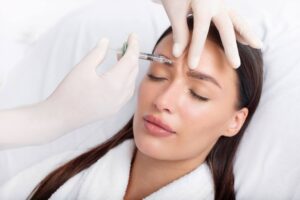If you’re considering dermal fillers, you may have noticed there are a lot of options available. With so many brands and types to choose from, it’s easy to get overwhelmed when trying to figure out which dermal filler is right for you.
Whether you’re hoping to smooth deep wrinkles, restore lost volume, or enhance facial contours, selecting the right filler can make all the difference in achieving natural-looking, long-lasting results.
We’re here to simplify the process and help you make an informed decision. In this article, we’ll explain the different types of dermal fillers, how they work, the key factors to consider when choosing the best one for your goals, and what to expect during and after dermal filler treatment.
What are Dermal Fillers?
Dermal fillers are a minimally invasive cosmetic treatment designed to restore volume, smooth wrinkles, and enhance facial contours. They offer an excellent non-surgical option for those looking to refresh their appearance without invasive procedures or downtime.
Dermal fillers can be used alone or combined with other medical aesthetic treatments like neurotoxins, though each serves a different purpose. Neurotoxins, like Botox, Xeomin, and Dysport, temporarily relax facial muscles to reduce the appearance of wrinkles caused by muscle movement. On the other hand, dermal fillers are gel-like substances carefully injected beneath the skin to restore lost volume and treat signs of aging.
While many assume there’s only one type of dermal filler, there are actually several, each designed for specific purposes to ensure the most natural and effective results.
Hyaluronic Acid (HA) fillers are the most common, but other materials are also used. Some fillers are formulated to provide a softer, more natural effect, making them ideal for smoothing fine lines or enhancing lips, while others offer firmer support for defining features like the cheeks, chin, or jawline.
The dermal filler procedure is quick, with little to no downtime, and results are visible almost immediately. Depending on the type of filler used, the effects can last from several months to over a year.
Types of Dermal Fillers
Many people assume all dermal fillers are the same. While they share similarities in that they all restore volume and improve the appearance of the skin, there are many different types of dermal fillers, each designed for specific purposes and outcomes. Additionally, these fillers come under a variety of brand names, each offering unique formulations to address different concerns.
Some fillers are temporary and reversible, lasting only a few months, while others offer longer-lasting results with minimal maintenance. However, longer-lasting fillers may not be as easily adjustable if you want to tweak your results later.
Here are the most common types of dermal fillers, their key benefits, and some well-known brands that you may recognize:
Hyaluronic Acid (HA) Fillers
Hyaluronic acid (HA) is a substance naturally found in the skin that retains moisture and keeps it plump and hydrated. HA fillers are the most widely used dermal fillers because they offer very natural results and are the most versatile.
Hyaluronic acid fillers are great for smoothing fine lines, adding volume to the cheeks, enhancing lips, and contouring the jawline. They are also commonly used for reshaping the nose in a liquid rhinoplasty because they can create smoother lines and enhance definition without being too firm.
HA fillers are also reversible. So, if you don’t like the results for any reason, they will dissolve on their own with time or can be easily dissolved with an enzyme called hyaluronidase.
Common brands of HA fillers include Juvederm® (Ultra, Voluma, Volbella) and Restylane® (Lyft, Silk, Defyne). One brand isn’t necessarily better than the other. They are both long-lasting and durable, however, the injection technique can vary. For this reason, the brand used often comes down to which one the practitioner is most comfortable using.
Calcium Hydroxylapatite (CaHA)
Calcium hydroxylapatite (CaHA) is a mineral-like substance naturally found in human bones. In dermal fillers, it comes as a thick gel with tiny calcium particles. These particles and the gel’s thick consistency allow for better definition and structure, making it ideal for shaping the face and adding volume to areas that need more support.
CaHA fillers are often used to treat deeper wrinkles, such as nasolabial folds, and add volume to areas like the cheeks. They are also used for facial contouring, such as creating a more defined jawline or liquid rhinoplasty.
CaHA fillers also help stimulate collagen production in the skin, which leads to long-lasting improvements in skin texture and elasticity.
The most common brand of CaHA dermal filler is Radiesse®.
Poly-L-lactic acid (PLLA)
PLLA fillers are a type of biostimulatory filler that works by stimulating your skin to produce more collagen over time. This type of dermal filler provides gradual, natural-looking results that improve over several months and is best suited for long-term improvement in skin texture, volume, and elasticity.
PLLA fillers are often used for overall facial rejuvenation, such as restoring lost volume in the cheeks and temples and addressing more profound volume loss in areas like the cheeks or temples.
The most common brand of PLLA filler is Sculptra®. Radiesse® is another brand of dermal filler that offers biostimulatory fillers to encourage the body to produce its own collagen.
Polymethylmethacrylate (PMMA)
Polymethylmethacrylate (PMMA) is a semi-permanent dermal filler that contains tiny, smooth microspheres suspended in a gel-like solution. These microspheres act as a support structure beneath the skin, providing volume and helping to smooth out wrinkles.
Over time, the body’s natural collagen production is stimulated by the filler, which helps to maintain and even improve the results.
PMMA fillers are typically used for deep wrinkles and to correct certain types of acne scars. Their results are semi-permanent, which is a pro. They provide longer-lasting results compared to other fillers, with effects that can last several years.
However, this can also be a con, as the filler cannot be easily reversed once injected. It is important to carefully discuss the treatment with your practitioner to ensure it’s the right choice for your needs.
The most common and widely known brand of PMMA filler is Bellafill®.
How to Choose the Right Dermal Filler
With so many dermal filler options available, it’s normal to feel overwhelmed when trying to figure out which one is right for you. The good news is, you don’t have to make that decision on your own.
It’s always a good idea to do your own research, but don’t stress about the filler type or brand. An experienced injector will help you choose the best dermal filler for your needs, helping you achieve the look you want with lasting, natural-looking results.
They will help you understand the differences between fillers and will work with you to identify the best filler based on your unique goals, concerns, and the results you’re looking to achieve. They’ll also consider factors like your skin type, facial structure, how much maintenance you’re comfortable with, and whether or not you want the option to dissolve the filler if needed.
Your practitioner will also take the time to understand what areas you’d like to treat and if filler is the appropriate solution. For example, if you want to smooth out crow’s feet around your eyes, they might suggest Botox or another neurotoxin instead. If you’re bothered by the hollows under your eyes, they might suggest using dermal fillers in the under-eye area, but they might suggest injecting the filler in your cheeks instead, as this can often restore volume and reduce the appearance of hollows.
To better prepare you for your consultation, here are some questions you might want to ask yourself and be ready to answer:
What are Your Specific Concerns?
Have a good idea of the specific areas you would like to address (e.g., wrinkles, volume loss, facial contours.) Different dermal fillers are tailored to treat specific facial areas. Knowing your primary area or areas of concern helps to narrow down the filler that best suits your goals.
What is Your Desired Look?
Ask yourself whether you’re aiming for a subtle enhancement or a more dramatic transformation. While the results should always look natural with a skilled injector, your desired level of change will influence the choice of filler and technique.
Do You Want Longer-lasting or Adjustable Results
One of the reasons people love dermal fillers is their longevity. While all fillers will eventually fade over time, some are designed to last several months, while others can provide results for many years. Additionally, certain fillers are dissolvable if you decide to make changes, while others are not.
Filler reversal is on the rise, but this could easily be avoided if you are educated upfront. To learn more, read “Too Much Filler? How to Know and What to Do.”
How Much Maintenance Are You Willing to Commit to for Follow-Up Treatments?
While dermal fillers provide long-lasting results, maintenance treatments are often needed to keep your appearance looking fresh. Some fillers may require touch-ups every few months, while others can last up to a year or more.
Consider how much time and effort you’re willing to invest in follow-up treatments to maintain your desired look, and discuss your options with your practitioner to find a solution that fits your lifestyle.
Are You Choosing a Trusted Practitioner and Safe Fillers?
When it comes to dermal fillers, your safety should always come first. That’s why it’s crucial to choose a trusted, experienced injector and only use FDA-approved products. These fillers have been rigorously tested for both safety and effectiveness, ensuring you get the best results with minimal risk.
While most skilled injectors consider using some fillers for off-label purposes (meaning they are not specifically approved by the FDA for a particular area) safe, you should always avoid going to a clinic that uses unregulated or discounted products. Cutting corners and seeking “Groupon deals” is not something you want to do. It can lead to unwanted side effects or disappointing results.
Have You Checked Before-and-After Photos?
Looking at before-and-after photos of previous patients can help you understand the potential results of your dermal filler treatment. Reputable practitioners can provide these photos during your consultation. This gives you a better sense of their skills and the type of results you can realistically expect.
What’s Your Budget for Dermal Filler Treatment?
Dermal filler treatments can vary in cost depending on the type of filler, the amount needed, and the provider’s experience. While staying within your budget is important, it’s essential to prioritize the quality of the treatment and the qualifications of the injector.
It is also important to consider your budget down the line. Some fillers may have a lower upfront cost but require more frequent touch-ups to maintain results, while others might be more expensive initially but can last for years without additional treatments.
Benefits of Dermal Fillers
Whether you want to smooth out wrinkles, restore volume to sagging skin, or enhance your facial features, dermal fillers deliver impressive, natural-looking results. Here are some key benefits of dermal fillers:
Non-surgical with Little to No Recovery or Downtime
Dermal fillers are a quick and easy procedure with minimal to no downtime. You can get back to your daily routine almost immediately.
Immediate Results
One of the biggest advantages of dermal fillers is the instant gratification. While it does take a few weeks for the product to fully settle, results are somewhat visible right after the treatment.
Long-Lasting
Depending on the type of filler, the results can last anywhere from several months to over a year. Some fillers even stimulate the skin’s natural collagen production, further enhancing the results over time.
Reduces the Appearance of Deep Wrinkles
Neurotoxins are often used for fine lines and wrinkles, but when it comes to deeper lines and wrinkles, dermal fillers offer a more effective solution for those who want to avoid surgery.
Restores Volume to Sagging Skin
As we age or even lose weight, we can lose volume in certain areas of our faces, leading to sagging skin. Dermal fillers help restore volume to areas like the cheeks, under the eyes, and around the jawline.
Enhanced Collagen and Elasticity
Over time, the body’s natural collagen and elastin levels decline, resulting in less youthful-looking skin. Some dermal fillers help combat this by providing structural support and stimulating the production of collagen and elastin, which improves skin texture and firmness.
Minimal Risk
When administered by a qualified professional, dermal fillers have a low risk of complications. Side effects are typically mild and temporary, such as swelling or redness at the injection site.
Where Dermal Fillers Can Be Used
Dermal fillers are versatile treatments that can enhance various areas of the face. Whether you want to add volume, smooth out wrinkles, or enhance certain features, there is a type of dermal filler that can be strategically applied to create natural-looking results.
Here are some common areas where dermal fillers can be used. If you do not see an area you would like to be treated, ask your practitioner. Dermal fillers can also be used in other areas by request, such as nasolabial folds, temples, smile lines, and even for reshaping the nose.
Lips
Dermal fillers can enhance lip volume and smooth lines around the mouth to create fuller, more youthful lips.
Cheeks
Fillers can restore volume to the cheeks, improving facial contour and giving a lifted appearance.
Under-Eye Hollows
If you have dark circles or hollows under your eyes, dermal fillers can help reduce this appearance and restore a more refreshed look.
Jawline
Dermal fillers can define and sculpt the jawline, creating a sharper, more balanced and youthful profile.
Chin
Fillers can be used to improve chin projection and balance facial features, creating a more proportional look.
Forehead
Fillers can smooth out deep wrinkles and fine lines on the forehead, giving a more youthful and relaxed appearance.
What to Expect During and After Dermal Filler Treatment
Dermal filler treatment is a safe, effective, and minimally invasive way to rejuvenate your appearance without the need for surgery. The treatment is quick, relatively painless, and requires little to no downtime.
Here’s a closer look at what you can expect throughout the process and the days following your treatment.
During Dermal Filler Treatment
Most people report feeling very little pain during dermal filler treatment, but to ensure your comfort, a topical numbing cream or local anesthetic is usually applied before the injections.
Once your consultation is complete and the numbing cream is fully absorbed, the procedure itself is very fast. Depending on the number of areas being treated, once you are numb, a dermal filler treatment session typically lasts anywhere from 15 minutes to an hour.
Your practitioner will carefully inject the dermal filler into targeted areas using a very fine needle. They will use their expertise to shape and contour your face, ensuring the results look natural and balanced.
After Dermal Filler Treatment
Once your dermal filler treatment is complete, you may notice some mild redness, swelling, or bruising in the treated areas. This is completely normal and should go away within a few hours to a couple of days at most.
You should see immediate results after the procedure, but it does take a little while for the product to fully settle. Dermal fillers work gradually; over time, you’ll continue to see improvements in your facial features.
Typically, you will see the full effect of your dermal filler treatment about two to four weeks post-treatment.
Dermal filler doesn’t require any downtime. Most people can resume all normal activities. However, to maximize your results and ensure the dermal filler settles properly, you should follow all aftercare instructions provided by your practitioner.
These instructions typically include drinking a lot of water, staying upright for a few hours after treatment, avoiding strenuous activities, excess sweating, and direct sun exposure for 24-48 hours post-treatment.
You might also be advised to sleep on your back with your head elevated for the first night or two, to avoid using makeup or harsh skin care products on the area for a short period, and to refrain from rubbing or massaging the treated areas for a couple of weeks (this includes facials and massages where your face is manipulated or pressed).
As far as longevity, how long your dermal filler treatment lasts depends on the type of filler used and the areas treated. Most fillers last at least a few months, with some providing results for years.
Conclusion
Neurotoxins like Botox are generally considered the most popular non-surgical cosmetic procedure, but dermal fillers are a close second. Their popularity is expected to continue rising as technology advances, and people become more aware of their versatile uses.
Whether you want to smooth out fine lines, restore lost volume, or enhance facial features, dermal fillers offer a safe, effective, and customizable solution. With so many options available, it’s important to work with a skilled practitioner who can guide you through the process and help you achieve your aesthetic goals.
At Relive Health, we have the most experienced and sought-after injectors in your area. They are highly knowledgeable in facial anatomy, advanced injection techniques, and filler formulations, ensuring you receive the best results tailored to your needs.
Check out our clinic locator and find a location near you to be matched with an experienced dermal filler injector who will guide you through the process and ensure you receive the best possible results.




